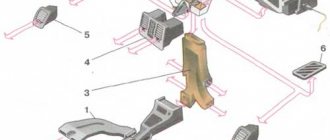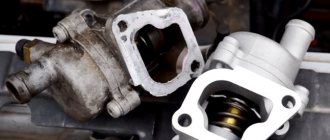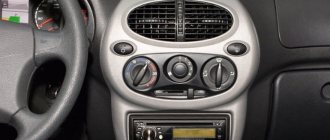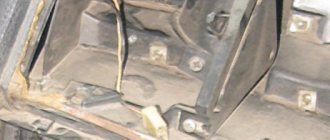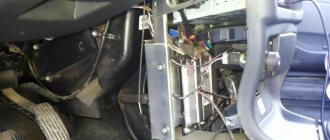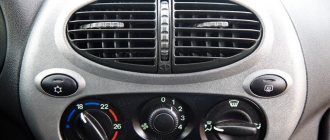A working stove in winter is not only comfort, but also safety. At sub-zero temperatures outside, moisture condenses on the car windows and freezes, covering them with a layer of frost, which significantly impairs visibility. In classic Zhiguli models, the heater copes well with the task assigned to it. With a working cooling system, the engine heats up in a short time, which directly affects the rate of heating of the interior. The absence of electronic control units simplifies the entire system and makes it more reliable. The damper and heater tap are controlled mechanically; only the fan is electrically driven.
Repair of the stove on a VAZ 2105 car
A working stove in winter is not only comfort, but also safety. At sub-zero temperatures outside, moisture condenses on the car windows and freezes, covering them with a layer of frost, which significantly impairs visibility. In classic Zhiguli models, the heater copes well with the task assigned to it. With a working cooling system, the engine heats up in a short time, which directly affects the rate of heating of the interior. The absence of electronic control units simplifies the entire system and makes it more reliable. The damper and heater tap are controlled mechanically; only the fan is electrically driven.
Stove malfunctions
Due to the simple design, there are not so many faults in the interior heating system of the VAZ-2107. They are divided into mechanical and electrical. Mechanical problems include:
- jamming of the antifreeze supply valve;
- radiator clogged;
- breaks in the drive mechanism cables;
- smudges.
The tap and heater radiator are the “weak” points in the VAZ-2107 stove. If in winter the tap works frequently, then with the onset of summer it turns off and remains in that position. Because of this, it jams, and when winter comes, attempts to open it lead to a break in the control cable.
Video: The heater on the classic VAZ 2101-07 does not work. We are looking for the reason.
It is difficult to “move” a faucet that is stuck in one position, so it is easier to replace the faulty unit. And cutting off the antifreeze supply also affects the radiator. The absence of fluid movement for a long period (when operating a car in the summer, when the stove is not in use) leads to intensive formation of oxides inside the radiator, which clog the heat exchanger pipelines. Because of this, the throughput of the radiator decreases, and with it the performance of the stove.
A clogged heater radiator is washed, but if there are a lot of deposits, then they can only be removed mechanically, and for this the radiator is unsoldered. Soldering it back is difficult and sometimes it is easier to replace the heat exchanger than to wash it.
Leaks are also a common failure. They occur at the junction of the pipes, and also if a crack appears in the radiator. In the first case, the leak is eliminated by tightening the fastening clamps, in the second - by soldering or replacing the radiator.
Diagnostics
If the stove on a VAZ 2105 does not heat well, you need to find out the reason why this is happening. Any manifestation of incorrect operation must first be diagnosed to identify the causes, and then proceed to troubleshooting.
- One of the main reasons may be a low level of coolant in the engine cooling system. And it would seem that it could be easier than checking the fluid level, but not in a Zhiguli. On the “classic”, the level is checked not in the expansion tank, but in the radiator. Moreover, it must be filled completely (up to the filler neck). And it is necessary to check the presence of liquid in the radiator, since due to the special design of the engine compartment, the presence of coolant in the expansion tank does not mean its presence in the rest of the system. And an insufficient amount of fluid entails not only a lack of hot air from the deflectors, but also more serious damage to the engine. Insufficient heat removal from very hot parts can lead to failure of the entire motor.
- The next important element, responsible for quickly reaching the operating temperature and maintaining it throughout the entire operation, is the thermostat, which is responsible for opening and closing the additional cooling circuit. If the thermostat is constantly open, the system cannot warm up to operating temperature, and then the heater will not warm up the interior sufficiently. You can diagnose this unit by touching the pipe after the thermostat and the cylinder block before it. On a cold engine, they should be at different temperatures: the block should be warm, and the pipe after the thermostat should be cool. If the temperature is the same, then the thermostat needs to be replaced.
- A very common problem is a faulty stove faucet. It may sour in one of the positions, or the passage channel may become clogged, which will impede the free passage of liquid through the heater radiator. Or the control drive (cable) may be damaged and not control the crane. You need to climb under the dashboard on the passenger side and, moving the heater switch, watch the movement of the valve. If the crane remains in place when moving the lever, it means that the integrity of the cable has been compromised.
- A closed damper can also cause poor performance of the stove. On a VAZ 2105 car, air is taken only from the street, and when the damper is closed, there is not enough flow to blow the interior, which negatively affects the operation of the heater.
- A clogged heater radiator impairs the free passage of fluid, which negatively affects the heating of the interior. Due to the lack of a cabin filter, the honeycombs become clogged with dirt and dust, which also impairs the performance of the heater. To diagnose the radiator, you need to remove the heater fan and, after warming up the engine, try by touch for uniform heating of the entire surface. If heating is not uniform, it means there is a blockage that is preventing the free passage of flow.
- Also an important factor influencing the operation of the heater is the density of the housing assembly and the density of the radiator in the housing. If the assembly is loose, air will flow through the cracks of the housing rather than through the honeycombs. And no heating will occur.
- A faulty electric motor or damaged blades can cause poor heating of the interior. If the fan does not start when you turn it on, or if you hear extraneous noise when you turn it on, it means that you need to dismantle the fan and carry out further diagnostics on the removed electric motor.
After the diagnostics have been completed, you can begin troubleshooting.
- If the coolant level drops, it is necessary to find the location of the leak and eliminate the leak. Then add liquid until the neck is full. Then remove the air plug from the cooling system by pushing through the rubber pipes with the engine running, and add fluid if necessary.
- To replace the thermostat, you need to drain the coolant, unscrew the thermostat cover and replace it with a new one. Then fill in coolant and get rid of the air lock, as described in point No. 1.
- To “break” a soured faucet, you can try to turn it manually (without a cable drive), and if it does not turn, you need to dismantle it and replace it with a new one. To do this, it is not necessary to drain the coolant; it is enough to clamp the pipes before and after the tap.
- You can try to lubricate a soured valve “remotely” by spraying water-repellent grease onto the hinge joint. If this procedure does not bring results, then you need to dismantle the entire heater and “develop” the damper.
- You can clean a clogged radiator by rinsing it with a special liquid or running water. But this will only help clean the inside, and the outside will remain clogged, so to achieve the maximum result from the work done, you need to remove it and wash it both inside and outside. If flushing does not produce results, then you need to replace the radiator with a new one. Before replacing, it is advisable to flush the entire cooling system, otherwise this replacement will have a positive effect in a short time.
- The body is fastened together with iron brackets; it is important that they all stand in place and tightly press the parts of the body to each other. The radiator must be sealed in the housing around the perimeter to prevent flow from passing through the honeycombs. It is better to use foam rubber for compaction.
- After checking the fuse and wiring of the fan, you can begin to dismantle it. Then assess the feasibility of repairing this unit. Before final assembly, you need to connect the motor to the standard wiring and check the functionality on the car. The fan impeller is made of plastic and can be damaged with slight force, so special care must be taken during assembly.
The diagnostic and repair methods outlined above will help you carry out repairs in the shortest possible time with minimal costs. After this, you will enjoy the warmth and comfort in your car for a long time.
The stove blows slightly warm air
Every owner of a VAZ classic has probably encountered this phenomenon, because all big problems begin with small ones.
However, even with diagnostics, things are not so simple here, because there can be many reasons why warm or cold air is blowing from the VAZ 2101-2104 stove.
For example, due to the fact that the heater fan motor rotates much slower than the nominal operating mode. This malfunction is a consequence of oxidation/contamination of the collector. Cleaning the commutator brushes or completely replacing the electric motor are possible repair options.
Bearing jamming usually leads to the same results - it is diagnosed by the appearance of creaks from the side of the stove, which intensify over time, up to the jamming of the armature shaft.
The second common reason why the VAZ-2101 stove heats poorly is insufficient warming up of the engine. If the temperature gauge needle does not rise to the required 90 degrees, it can be assumed that the thermostat is jammed, and in a position where coolant is constantly circulating through a large circuit. In this case, you will need to replace the thermostat, which can be done independently on a penny:
- you need to work with a cooled power unit installed on a level surface;
- unscrew the plugs of the main radiator and expansion tank;
- pour the antifreeze into a previously prepared container of suitable volume (about 3 liters);
- tighten the drain plug;
- Using a flat-tip screwdriver, loosen the clamps of the pipes connected to the thermostat;
- dismantle the thermostat;
- We replace it with a known working one;
- We carry out all other work in reverse order.
After the coolant is added to the norm, we start the engine and monitor how the thermostat behaves by feeling its pipes - the lower one should remain cold until the engine warms up to 85-90 degrees.
Heater air duct VAZ-2101
Another common reason why the VAZ-2101 stove does not heat is contamination of the stove radiator. As a result, the heat transfer of the device is sharply reduced (which is facilitated by both the deterioration of antifreeze circulation and the decrease in heat transfer due to the adhesion of scale and other contaminants on the external and internal walls of the tubes).
How do you know if a clogged radiator is to blame for the lack of heat? It’s very simple: with the engine warm, check the inlet and outlet hoses by touch. If the first one is hot, and the second one is much colder, it is obvious that heat loss occurs precisely in the stove radiator.
It can be revised, but it is better to replace it with a new one - the decision is made after its dismantling based on the results of the inspection.
Here is the algorithm for dismantling the “kopek” stove:
the user instructions recommend draining the antifreeze, but in this case, due to the loss of a small volume of liquid, this may not be done (no more than a liter of antifreeze will spill out); from the engine compartment side, loosen the clamps on the radiator flanges and pull off the pipes
You need to work carefully - the hoses usually stick, and it will take a lot of effort to remove them; unscrew the cover of the rubber seal and dismantle it; go to the interior, unscrew the screws holding the car radio panel (if any); loosen the fasteners for the heater faucet drive, disconnect the cable; unscrew the brackets securing the fan casing; we move the casing down and to the left - it will not be possible to completely dismantle it due to the electrical wiring; we take out the stove radiator from the casing.. VAZ-2101 stove fan
Heater fan VAZ-2101
Now you can begin a thorough inspection of the radiator, as well as the stove faucet. If the tubes have traces of through or almost through corrosion, further inspection can be stopped - it will not be possible to repair such a radiator.
If the condition of the radiator is more or less tolerable, you can try to clean it using store-bought or “folk” remedies.
We also check whether the faucet handle is stuck - this usually happens if the stove has not been used for a long time (it has not been turned on throughout the warm season). We replace the faucet if traces of leakage are also found on its surface.
When installing a new or restored radiator, do not forget to install new gaskets, which can be pre-lubricated with silicone - this will prevent possible leaks. We perform the same operation in relation to the rubber pipes connected to the radiator. Add the required amount of antifreeze and check the operation of the stove, as well as the tightness of all connections.
Why the stove on the VAZ-2105 does not heat well and what to do
Today we will try to figure out why the stove on the VAZ-2105 does not heat well in winter.
If the car takes a long time to warm up or cold air is blowing directly into your cabin, then there can be many reasons - from banal inattention to really serious problems. For this:
- check the thermostat. This may be the reason; if the hoses are hot, it is most likely jammed open;
- The air intake may be closed: check and open manually if necessary;
- gasket: if it is broken, gases from the combustion chamber can flow towards the cooling system. To understand whether this is really the reason, you need to look into the expansion tank in a warm car: if there are bubbles there, the gasket is broken. These bubbles most often can get stuck in the pump and stove;
- check the pipes from the stove. If they are cold, and you have a whole gasket, then you can simply remove the air from the stove. Poor pump flow is also possible;
- It may also be that the cable at the heater valve drive cannot open it because the cable braid comes off and does not push the valve handle. In this case, you can correct it manually;
- Another reason that the stove does not work well may be a violation of the polarity of the heater engine brushes: if you have reverse polarity of the air, then it will move from the passenger compartment to the engine compartment. It shouldn't be this way.
How to improve airflow yourself
The air conditioner removes moisture from the interior well and improves glass blowing. It's summer. In autumn it is cool to use it, but in frost it is undesirable. We need to study the ventilation system.
You need to start by examining the air intake. If it is clogged, the carpets in the driver's and front passenger's cabin are damp, or even damp. It is necessary to carry out measures to clean the airways.
Next you should look at the cabin filter. They probably forgot to change it in time. Increased interior humidity indicates a necessary replacement. Some car owners don't put it back at all. But this affects the quality of the inhaled air and increases the level of humidity in the car.
A failed recirculation valve is easily identified. They understood the cabin filter, but there is no feeling of fresh air inside the car. In the Toyota Corolla 150 body, it is located on the left under the dashboard. You can take out the cabin filter and open the valve manually through the hole in the shelf, but it is better to repair the damper opening mechanism. The control cable may be loose or the sensor may be faulty.
If all else fails, then the car has such a feature. You can improve the airflow for your windshield yourself. Refining the windshield blower will not require expensive funds. You will need an ordinary indoor ventilation grille. Buy it without frame.
Pre-measure the length of the deflector holes. You need tape or glue, car paint.
Removal process
- Drain the coolant.
- Loosen the clamps and disconnect the pipe that comes from the radiator and the inlet.
- Loosen the clamps themselves.
- Remove the pipes by disconnecting them from the water pump.
- We take out the thermostat. Disconnect the remaining pipes.
When installing the thermostat, you need to take note that this is a serious operation and must be carried out carefully:
- Clean all surfaces thoroughly and replace the O-ring.
- Correctly orient and place the thermostat in the housing.
- Next, tighten all existing cover bolts. To be able to do this, you need to try.
- Reinstall all hoses in their original locations, then fill with coolant.
- You should also start the engine until it reaches operating temperature to make sure there are no leaks.
Replacing the heater valve for better heater operation
It is best to use ceramic faucets rather than metal ones. So let's get started:
- you need some kind of container;
- find the plug on the block and unscrew it to drain the coolant;
- You will still need the container with the liquid, but for now put it away;
- we find the pipes, then unscrew the clamps;
- using a metal brush, clean the threaded connections of the two studs (you can moisten them with brake fluid to make them unscrew better);
- While this whole thing is settling down, we remove the pipes and go to the interior, where we remove the side panel of the torpedo;
- unscrew the pipe clamps;
- Having removed the pipes, we replace them;
- You need to find the nuts under the car that secure the heater valve. Unscrew;
- Returning to the salon, remove the tap and spring retainer;
- Next you need to disconnect the control cable from the crane;
- We install a new heater valve, but first connect the cable and attach the valve to the body.
Engine pump faulty
A pump is essentially a mechanical (sometimes electric) engine pump that pumps hot liquid through the system. That is, from the power unit block, through the pipes and further into the radiators for cooling. And in our case, for heating the interior.
It is an “impeller” that is inserted into a metal cylinder through which liquid passes. The impeller rotates, thereby pushing antifreeze (TOSOL) through the system. If there were no pump, then cooling the motor would be extremely ineffective, it would quickly overheat.
Very often, the pump is driven by a belt drive from the crankshaft of the power unit.
The main breakdowns are:
- Sometimes the crankshaft belt breaks, the pump does not rotate and does not circulate the coolant through the system. Accordingly, the stove does not heat. However, the power unit will also overheat.
- The pump itself is jamming. It does not rotate, or the internal part of the “impeller” does not rotate.
- Eats the inside. Due to the “crappy” quality of the metal, the internal impeller can be eaten away by aggressive antifreeze or antifreeze. Therefore, purely physically, the pump pulley rotates, but the liquid pumps through the system very poorly. Again, the stove does not heat.
For all reasons, the pump needs to be changed. I’ll say right away that the first “bells” may be a whistling sound in the engine compartment, a hot hose before the pump or heater, but a cold one after.
Replacing the heating fan
If your car is cold, it could be the fan. Now we will tell you how to replace it:
- Remove the bottom of the heater, then the old fan.
- Cut off one of the aerodynamic ridges that supplied air to the legs.
- Increase the diameter of the hole in the impeller. Push the new shaft into it.
- You need to check the operation of the fan, adjust the resistor and reassemble everything in reverse order.
We hope that our recommendations will help you put your classic VAZ-2105 in order!
Does the stove on the VAZ 2107 heat poorly?
And the cold is coming again. For those whose interior heater on a VAZ 2107 does not heat well, the question arises - how to make the “stove” heat better? Most 7 car owners are dissatisfied with the operation of the stove or interior heater. Indeed, the stove efficiency of the classics of this brand is very low.
But this problem can be solved by modifying the stove yourself. To improve the operation of the heater, you do not need special tools or skills; everything is done using improvised means.
Other problems with the heating system
Although heater radiator breakdowns occur most often, there are other malfunctions that can be easily fixed with your own hands:
- Fan motor failure. Problems are created by the rotor bushings, which on the “original” motor are made of low-quality material. As soon as the heating system fan begins to whistle, it needs to be replaced with a non-original one, in which bearings are installed instead of bushings.
- Heater valve wear. It suffers from scale, dirt, and simply wears out. Cranes are usually not repaired, but replaced. It is better to replace a faucet with a ceramic core; it is much more reliable and durable than a metal one.
- Breakage of control unit rods. Everything is clear here: what should be regulated is not regulated - check the condition of the rods and their connection. Sometimes the problem is solved in just half an hour.
More complex work, such as tuning or modifying the stove, is no longer considered troubleshooting. Of course, the stove on a VAZ opens up endless possibilities for improvements and additions, but you can get by with what you have at the moment. The main thing is that everything works as it should, and then you definitely won’t freeze in winter.
It is better to check the heating system before the time comes to use it. In the summer it is more comfortable and easier to do repairs; you can take your time and look for high-quality and inexpensive spare parts, and generally come to the cold season fully armed. In most cases, when the VAZ 2107 stove does not heat, you can correct the situation yourself. You just need to have straight hands and the desire to do the repairs correctly and efficiently.
Why the stove on the VAZ 2107 does not heat well, reasons:
A common cause is an underheated engine.
Signs: The temperature gauge is in the white zone, the engine takes a long time to warm up. At an outside temperature of -20, within 8-10 minutes of idling the engine, it should warm up to 40-50 degrees (the very beginning of the white zone of the temperature gauge). If the temperature rises less, it’s bad (the thermostat is faulty), higher is good. Next, you need to drive in 1-2 gears, and in 5-8 minutes the temperature should rise to 80 degrees (the border of the green and white zones). If the engine has not warmed up to 80, replace the thermostat!
Air in the cooling system.
First of all, you need to check the antifreeze level in the expansion tank and the serviceability of the radiator cap. If the radiator cap is faulty, air will remain in the system, which will result in poor circulation of coolant and, accordingly, cold air in the cabin.
The stove blows poorly to the left
The lower flap is completely open, or its latch is broken. To fully blow the glass, this damper must be closed. If it does not lock, you can use an elastic band, hooking it onto the “choke” handle, or somewhere else.
The stove alternately blows hot/cold air
The most obvious reason for this particular problem is the presence of air in the cooling system line. As a rule, the VAZ-2101 stove does not heat well due to the fact that air pockets do not allow coolant to circulate as expected, and due to its deficiency in the heater radiator, problems periodically arise with heating the air supplied to the cabin.
Reasons for the formation of CO airiness:
- adding antifreeze without following the correct technology;
- depressurization of the cooling system line (the leaking coolant is replaced by air - laws of physics);
- The expansion tank valve is faulty.
If the cause of airiness is an antifreeze leak, it must be detected and eliminated. The problem with a faulty valve is solved by replacing the expansion tank plug.
In any case, you need to get rid of the airiness. This is done in the standard way: unscrew the engine cover and, with the engine warmed up to 90 degrees, press the accelerator pedal several times almost all the way for 3-5 minutes. A good gas release should expel air from the system, but to obtain guaranteed results it is advisable that the front of the car is raised (a gradient of 15º is sufficient).
Modification of the VAZ 2107 stove so that it heats better.
As practice shows, the stove radiator gives off a sufficient amount of heat and its improvement is not required. This means that in order to increase the efficiency of the heater, the airflow system needs to be modified. Coat all air ducts with sealant, especially at their connections. This especially applies to VAZ 2105 - 2107 cars, due to their design features of the air ducts.
Replacing the stove motor.
The stove can be improved by installing a snail instead of an engine with an impeller, as used in VAZ 2108-2109 models. This tuning will increase air flow and reduce noise. The motor used in these models differs from the seven in its increased speed and greater power. To install it, a slight modification to the stove body will be required - due to its larger size, it is necessary to remove the comb, which directs the air flow to the feet.
You can leave the original impeller, but you need to enlarge the hole in it with a diameter of up to 7 mm, for the motor shaft from the figure eight.
Such modification of the stove also requires replacing the switch and resistor. Both parts are taken from the same model as the motor. The VAZ 2107 switch is designed for a lower current, and when used with a powerful engine it can simply melt. The native resistance of the VAZ 2107 will not allow the motor to operate at full power, which is why the resistor is changed.
We start by completely disassembling the heater housing. Almost everything is cut off from the bottom of the stove, except for the fasteners and frame. Next, we make the body for the snail. For this purpose, you can use any durable material - polycarbonate, plastic, plexiglass, etc. The four walls of the future body are cut out of the material (that you have chosen) and screwed to the bottom of the stove.
After all the steps done, we put the lower part on the middle one, first remove the diffuser. The dimensions must be adjusted so that the snail fits exactly into the body and does not protrude beyond the radiator mounts located on the middle part.
At this stage of work, you should pay special attention; if the body turns out to be large, then you will not be able to install the stove in its normal place. After accurately adjusting the dimensions of the new housing, all joints must be coated with sealant.
Let's take care of the air ducts. You can use commercially available plumbing hoses and cuffs. In the new stove body, holes of a suitable diameter for the cuffs are cut in the bottom, on both sides. Hoses are installed in them - the side ones are connected to the right and left air ducts, the lower ones away from the legs, to exhaust the warm air flow.
To heat the rear passengers, you can additionally install a pair of longer hoses. The amount of heat given off by the stove radiator and the power of the snail are quite enough for everything. The places of the side air ducts and hose connections are coated with sealant to prevent loss of warm air.
Such a modification will increase the efficiency of the stove on the VAZ 2107 by 2-3 times, both in the quality of glass blowing, a large flow of warm air does not allow the windows to fog up, and in heating the interior. This modernization of the interior heater is available to everyone and does not require large expenses.
Note: it should be remembered that when installing the volute and motor, the switch must be replaced. Make sure the heater fuse has the current rating required to operate the modified heater.
Conversion of the VAZ-2108 stove (snail) to VAZ-2107: video
Cleaning the radiator of a car heater
What to do if the stove blows cold air and the radiator needs to be flushed? There are several ways to do this.
1. Flushing the radiator with complete removal.
Dismantling a radiator is quite difficult; you cannot do it without knowledge of the car’s structure. However, in certain cases there is no other way to fix the problem. If you do not have positive experience with flushing the radiator, you should seek the help of professionals by contacting a service center.
Flushing with removal of the stove is required when other methods of cleaning the radiator have proven ineffective.
By removing the heater radiator, you can detect a number of faults. For example, you can see if the fan is functioning normally, and if there are problems, replace its motor.
In addition, only by dismantling the radiator can it be washed from the outside. If your car does not have a filter, be prepared for a large amount of dust and debris to accumulate on the air intake. The most dangerous is poplar fluff, which forms a thick caked crust. As a result, the heat exchanger stops blowing and generating heat.
You can assess the condition of the pipes, the degree of contamination of the radiator cells, as well as how tightly the air duct dampers fit when they are closed by removing the radiator. If in the closed position there are voids between the dampers and the stove, then air will come from outside, bypassing the radiator. Owners of not only budget but also expensive cars may encounter a similar problem. In the latter case, you should immediately contact a car service to solve the problem.
By dismantling the radiator, you can understand whether the cooling system as a whole is working. If the radiator is not functioning, cleaning will not help; you can solve the problem by replacing the entire cooling system. The cooling system becomes dirty gradually, but the moment the stove fails due to blockage is always unexpected. Repairing copper radiators involves sealing them, but if we are talking about aluminum, then replacing it will be a more expedient and cheaper solution to the problem.
Radiators are washed without using a pump, a sufficiently powerful pressure of hot water and a special bath. Washing is carried out using both homemade and professional cleaning products. Some methods are only suitable for a removed radiator, and using them at home is dangerous to health.
2. Washing with sulfuric acid.
To flush with sulfuric acid, the radiator must be removed, otherwise the rubber and plastic parts of the cooling system may be damaged. Today, this method is used very rarely and requires careful adherence to safety measures.
It is imperative to use special goggles, rubber gloves, a gown and a household respirator to protect against inhalation of toxic fumes. In addition, it is necessary to use special tongs or grips that prevent direct contact with the solution.
You also cannot do without a hydrometer, with which the concentration of the washing liquid is measured. Washing is carried out with a 15% solution of sulfuric acid. The hydrometer reading should be 1.1 g density per 1 cm3. The solution contains distilled water and battery electrolyte.
Remember that you should never pour water into acid; the acid must be carefully added to the water.
The method is suitable for flushing old copper radiators. Aluminum or zinc elements will fail after such treatment.
3. Cleaning with hydrochloric acid solution.
You should also not resort to this method if you lack experience. In addition, hydrochloric acid is not commercially available. As in the previous case, strict adherence to safety precautions is necessary.
If the contamination that has caused the stove to blow cold air is strong enough, then the cooling system should be filled with a 2% acid solution (50 ml per 1 liter of water). Then you will need to thoroughly and carefully flush the system with plain water. If the radiator is made of parts that are susceptible to corrosion, this cleaning method is not suitable.
4. Washing with caustic soda (caustic soda).
This method also causes heated debate. When using it, you must follow safety precautions; you cannot start washing without protective gloves; in addition, keep in mind that soda can corrode fabrics and is toxic.
Caustic soda is an alkaline detergent that cannot be found commercially. Using even a 5% solution will damage an aluminum radiator. The product is also harmful to zinc parts, zinc and aluminum alloys. It is recommended to be used if it is necessary to clean equipment before repair.
The most likely reason why the stove on a VAZ 2104 does not work....
and other “classic” models - the heater radiator is clogged, and the more clogged the radiator honeycombs are, the worse it will give off heat.
But before blaming the stove radiator for everything, you definitely need to check:
- Coolant level in the expansion tank.
- visually the liquid should be slightly less than half.
- Is the cooling system full of air?
- when the engine is warm, the supply pipe should be warm (it is indicated by an arrow in the figure).
- The functionality of the stove tap.
The heater valve is located on the passenger side under the glove compartment. (the figure shows a radiator with a valve in the removed position and an arrow roughly indicates where to look for the heater valve when it is installed).
The figure shows a radiator with the valve in the removed position and an arrow indicating approximately where to look for the heater valve when it is installed
- Warm up the car to engine operating temperature
- We try the pipe that supplies coolant to the tap, it should be warm (this way we make sure that there is fluid circulation through the system).
- On the panel of ventilation control levers, move the upper lever all the way to the right (the heater valve is open).
- We try the pipeline that goes from the tap to the stove, just be careful not to get your hands on fire, the pipeline must be warm. To be sure, turn on the blower fan; a couple of seconds after opening, warm air should come out.
If the pipeline from the tap is cold and there is no outlet of warm air, then there are 3 reasons:
- The cable that connects the control lever and the tap has broken,
- The cable is intact but rusted to the casing,
- The faucet simply “sours” and does not turn. This is a very common reason because after traveling through the warm season, which is 5-6 months, we do not use the stove. Then we try to turn the flag with our hands to the open position; if my memory serves me correctly, we need to turn it counterclockwise, but if you have a new tap on hand, it’s better to look at the open/closed position on it. As often happens, the faucet becomes so sour that the flag bends due to the force of your hand, then we remove the flag and try to twist it with pliers.
A couple more points:
- Before checking the tap, in order to save your nerves and not remember the VAZ designers once again, it is better to remove the shelf that is located under the glove compartment.
- I would like to say on my own that if you buy the cheapest faucet, you will most likely have to change it before the first winter.
If there is fluid circulation through the system, the antifreeze level and the heater tap are normal, then we turn our attention to the radiator, which is located in the cabin. It needs to be removed; many people are afraid of this procedure and take their time to debug the work. And if, God forbid, your radiator leaks a little, all the liquid collects under the rugs, which is hard to notice if you rarely do general cleaning. As a result of increased humidity in about a year, the bottom can literally rust from the inside.
Ryazan City Forum
- Unanswered messages
- Active topics
- Search
- our team
VAZ-2105 stove operation
- print version
VAZ-2105 stove operation
- Quote
Post by zoOm » Jan 18, 2011, 11:19 pm
Re: VAZ-2105 stove operation
- Quote
Post by Avrely » Jan 18, 2011, 11:32 pm
Re: VAZ-2105 stove operation
- Quote
Post by zoOm » Jan 18, 2011, 11:58 pm
Re: VAZ-2105 stove operation
- Quote
Post by Avrely » Jan 19, 2011, 00:07
Re: VAZ-2105 stove operation
- Quote
Post by zoOm » Jan 19, 2011, 00:11
Re: VAZ-2105 stove operation
- Quote
Post by Avrely » Jan 19, 2011, 00:17
zoOm No, but it's better to do it warm. To do this, you need to drain almost all the antifreeze, buy a new thermostat (good), perhaps new clamps. And it would be nice to have sealant on hand. In the worst case, you will need rubber pipes. But this may only be needed on a used car, and even then not always.
Re: VAZ-2105 stove operation
- Quote
Post by zoOm » Jan 19, 2011, 00:20
Re: VAZ-2105 stove operation
- Quote
Post by Avrely » Jan 19, 2011, 00:24
zoOm if it’s cloudy, change it, of course. only then should it be drained completely, incl. from the block. touch the pipes - if the rubber is elastic, not “oaky”, then there is no need to change anything. a thin layer of sealant on the thermostat journals for guarantee, and new clamps (not Chinese)
But, nevertheless, first hold your hand on the radiator in the morning, not on the top tank, but lower, towards the middle. If it warms up slowly, the thermostat is definitely dead.
Re: VAZ-2105 stove operation
- Quote
Post by zoOm » Jan 19, 2011, 00:27
Re: VAZ-2105 stove operation
- Quote
Post by Avrely » Jan 19, 2011, 00:31
Re: VAZ-2105 stove operation
- Quote
Post by rescuer » Jan 19, 2011, 12:33 pm
Re: VAZ-2105 stove operation
- Quote
Post by zoOm » Jan 20, 2011, 10:44 pm
Re: VAZ-2105 stove operation
- Quote
Post by DS » 21 Jan 2011, 01:29
Re: VAZ-2105 stove operation
- Quote
Post by andreyko76 » Jan 21, 2011, 11:03 am
Re: VAZ-2105 stove operation
- Quote
Post by andreyko76 » Jan 21, 2011, 11:20 am
Re: VAZ-2105 stove operation
- Quote
Post by Damir » Jan 21, 2011, 2:33 pm
Re: VAZ-2105 stove operation
- Quote
Post by zoOm » Jan 21, 2011, 8:26 pm
Re: VAZ-2105 stove operation
- Quote
Post by Avrely » Jan 21, 2011, 8:34 pm
Repair of the VAZ-2107 heater or why the “stove” does not heat?
Why doesn't the VAZ-2107 stove heat up?
And again the weather threatens to be cold. For those who have problems with their heater, the most important question is how to make the “stove” heat up? First of all, let's determine the cause of the malfunction. The culprit may be an underheated engine, an airy cooling system, or a malfunction of the heater itself. If the stove fan does not spin, the electrical wiring is faulty - see here.
Often, the cause of cold in the cabin is an underheated engine.
Signs: the temperature on the gauge is in the white zone, the engine takes a long time to warm up. Normal warming up at a temperature of -20 looks like this: start the engine, in 8-10 minutes at idle the engine should warm up to 40-50 degrees (the very beginning of the white sector of the temperature gauge scale). If the temperature rises higher, it’s good, less is bad. Thermostat is faulty. Then we drive in 1-2 gear, and in 5-8 minutes the temperature rises to 80 (the border of the white and green zones). did not warm up to 80 - the thermostat needs to be replaced! Temporarily, you can get by with insulating the radiator with cardboard or something else. But don’t forget that if you put a load on the engine (it’s stuck and slipping), it can boil. Therefore, the cardboard should be pulled out easily and quickly.
Air in the cooling system
First of all, we check the antifreeze level in the expansion tank and the serviceability of the radiator cap. If the antifreeze is diluted with water, it’s bad, it will harden, it needs to be replaced. If the radiator cap is faulty, air will remain in the system, and this will lead to poor circulation and coldness in the cabin. We buy and install a new plug, add antifreeze and the deficiency disappears.
An air lock may remain even after repairing the cooling system. Remove the air by driving the car, preheated to 80 degrees. engine, uphill to raise the front end. Then, having removed the radiator cap, drive the engine at 2000 - 3000 rpm for several minutes. After the air comes out, all that remains is to add antifreeze and close the radiator cap.
Next, check the correct position of the stove control levers
Blue - controls air supply. Red - antifreeze supply tap. They must be open (all the way to the right). Sometimes the tap turns sour. Find it under the glove compartment and check - it should open all the way, you can help with your hand, simultaneously with the lever. Just work carefully, the parts are thin and fragile and can be broken. It is convenient to move the lever with your left hand and turn the tap with your right.
VAZ 2107 heater valve in the open position
Heater valve in closed position
We check the operation of the air damper with the fan turned on. The lever to the right from the stove blows strongly, to the left it blows much weaker. If there is no difference, it’s bad - the cable has come off, the stove will have to be removed.
The stove blows poorly on the left side
The device of the heater (stove) VAZ-2107
The third lever controls the distribution of warm air between the windshield and side windows. The cable that leads to it (21) controls three dampers - (20) two of them open and close the air supply to the side windows. The third damper is not visible in the figure; it is located here (22) and can block the air outlet to the windshield. Lever position: points to the right on the windshield, points to the left on the side windows. Why does it blow badly on the left side? 1. The fan at the stove is designed in such a way that it turns warm air to the right side, and the left side gets less. This is a design feature and is difficult to change. 2. The stove was disassembled and the air duct (4) or the left damper was damaged. 3. You completely open the lower flap with handle (1), or its latch is broken. For normal glass blowing, this damper must be closed. If the latch is broken, you can adjust the rubber band by hooking it onto the “choke” handle or somewhere else.
Some craftsmen install an additional fan from a computer processor in the deflector (4) of the pipe. You can buy and install a fan on the dashboard with a connection to the cigarette lighter, direct it to the side window and set the speed to a lower speed.
Another reason is poor circulation of antifreeze through the stove
We check the circulation like this: the engine is warmed up to 80, at idle we bring our hand to the outlet of the heater (near the driver’s right foot), give it gas and keep the speed at 2500. If you feel that the air has become noticeably warmer, you have poor circulation through the heater. Reasons: - clogged heater radiator, if the car is old and you poured “sealants”, mustard and other nasty things into the radiator; - there is a non-standard stove valve (ball, ceramic), which has channels of reduced diameter, or does not open completely. There are defective taps. It can block the circulation so that the antifreeze flows in a thin stream. After replacing it with the original faucet, the heat will return. More precisely, we check the circulation like this: at idle, with the engine barely warm (20-30 degrees), remove the upper rubber pipe at the outlet of the stove (under the hood) and place some dishes. The stream should be thick enough and even. A thin trickle, barely running - remove and check first the faucet, and then (if the faucet is in order) the radiator. You can try to rinse a clogged radiator with hot water (into the hole where the tube is), sometimes this helps.
How to turn on the stove
The stove on the VAZ 2107 has: in fact, a toggle switch for the rotation speed of the stove fan, and three sliders - we’ll dwell on them in a little more detail. Upper: position all the way to the right - fully open the stove tap (maximum temperature); Middle: to the right all the way - air intake from the street, to the left - from the cabin. As a rule, it heats up faster when taking air from the street. Lower: extreme left position – heated side windows, right – heated windshield.
With this position of the sliders it will be warm.
If the stove shows no signs of life, it would be a good idea to check the fuses - there is an electrical diagram in the book for the car. If this is too difficult for you, you can go to an auto electrician.
Can the stove break?
Nothing lasts forever, and the stove on a VAZ 2107 can also fail. Let's briefly consider the main causes of breakdowns:
- on a new car:
1 – Electrical fault: fuses, heater motor, switch fault. 2 – Air lock (occurs when replacing coolant).
- on an old car:
There are a few more reasons here. With an old car, the troubles described above and several other problems can occur.
1 – The stove radiator is clogged (the honeycomb is clogged). 2 – Thermostat malfunction. 3 – Malfunction of the liquid supply valve.
What is needed to fix a malfunctioning stove?
If you repair the car yourself, then some problems can be fixed yourself. If not, go to the service station. If the heater does not turn, check the fuses, heater switch. Please note: after our “Kulibin Homegrown”, the following may happen - the stove will only work when the ignition is on - do not forget about this.
If there is no heat, the problems are as follows: thermostat, air lock, heater valve. If the stove tap opening slider moves heavily, try opening the tap manually - it may be stuck. There is a faucet on the passenger side next to the heater radiator - try opening it. I want to disappoint you: the standard taps are of disgusting quality, and it may happen that the tap turns but does not open - then the only option is to replace the tap.
An air lock occurs when replacing the coolant. The solution is the following: place the car on a flat surface and let out the air.
Thermostat malfunction. In this case, the interior heats up very slowly when the engine is cold, but everything is fine while driving. The thermostat may be faulty and causing fluid to circulate in a large circle. Without going into details, I will say that this option is bad both for the engine and for you, in terms of heat. It is better to replace the thermostat at the station, or at least get advice.
The honeycombs are clogged. The problem with old cars is when scale appears in the radiator honeycombs, which impairs fluid circulation. Either remove the radiator and wash it, or replace it with a new one.
And the last thing: if the stove hums, but does not heat. After all of the above, I’ll add again: perhaps the reason is hidden in the incorrect location of the stove control sliders . The purpose of the three sliders was described above. Check to see if your windshield heating is turned on - the heater seems to be working, but the air in the cabin heats up too slowly. Author: Igor Especially for the site “behind the wheel after 30″.
